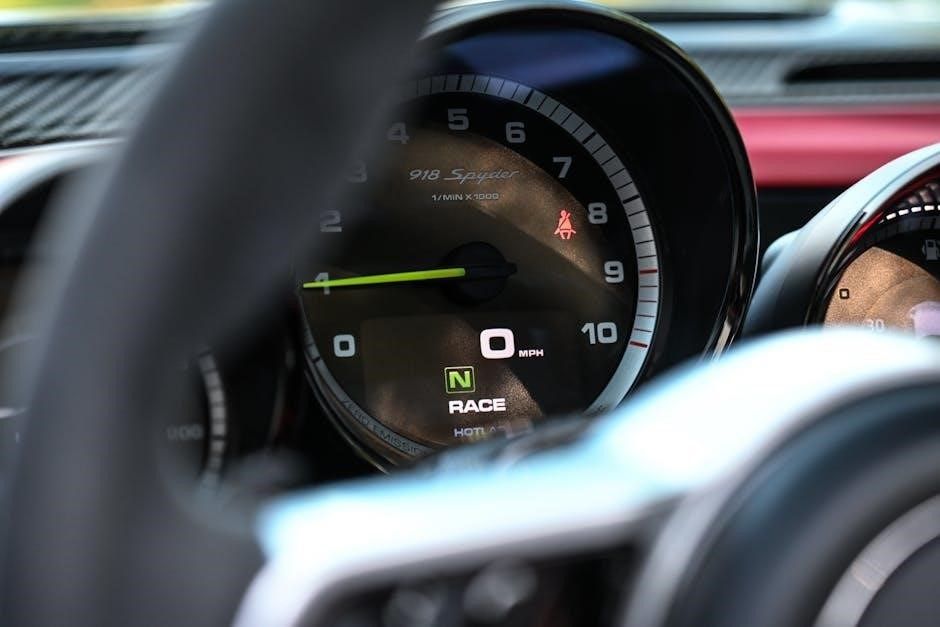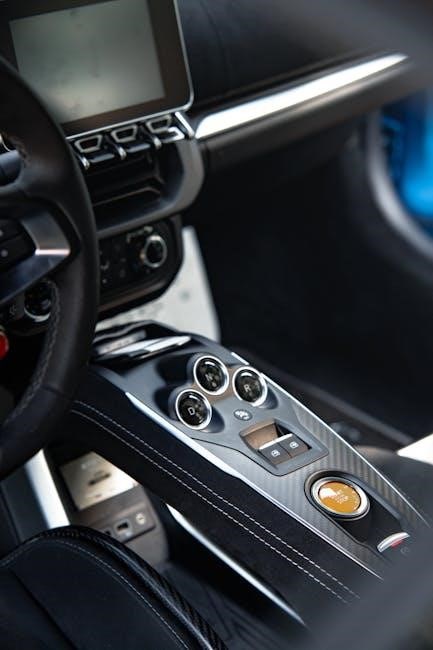Power steering and manual steering are two distinct systems that assist drivers in controlling vehicle direction. Power steering reduces effort using assistive technology, while manual steering relies solely on driver effort and mechanical linkages. Understanding their differences is crucial for choosing the right system for specific driving needs and preferences.
1.1 Overview of Power Steering
Power steering systems enhance vehicle maneuverability by reducing the effort needed to steer. They utilize assistive technologies, such as hydraulic or electric mechanisms, to aid drivers in steering. This innovation improves control and reduces driver fatigue, especially in low-speed conditions. Modern vehicles predominantly feature power steering due to its effectiveness and the enhanced driving experience it provides.
1.2 Overview of Manual Steering
Manual steering relies entirely on the driver’s physical effort to turn the wheels. It operates through a mechanical linkage system, connecting the steering wheel to the vehicle’s axles. This setup provides direct feedback and precision, often preferred by drivers seeking a more engaging experience. However, it demands greater strength, especially at low speeds, making it less convenient for everyday driving compared to power steering.
1.3 Importance of Understanding the Differences
Understanding the differences between power steering and manual steering is essential for making informed decisions about vehicle choice. It helps drivers select systems that align with their driving habits, vehicle type, and maintenance preferences. This knowledge also aids in optimizing performance, safety, and cost efficiency, ensuring a better driving experience tailored to individual needs and environmental conditions.

How Power Steering Works
Power steering uses assistive technology to reduce driver effort, utilizing a combination of hydraulic or electric systems. The power steering system, including a motor or hydraulic pump, reduces physical effort required, especially at low speeds.
2.1 Components of Power Steering Systems
Power steering systems consist of a power steering pump, reservoir, hoses, and valves for hydraulic systems, while electric systems use an electric motor, sensors, and control units. These components work together to reduce steering effort, improving maneuverability. Hydraulic systems rely on fluid pressure, while electric systems use sensors and motors to assist steering, both enhancing driver comfort and control.
2.2 Hydraulic vs Electric Power Steering
Hydraulic power steering uses fluid pressure to assist steering, while electric power steering (EPS) relies on electric motors. Hydraulic systems are robust and provide consistent feedback, making them suitable for heavy-duty vehicles. EPS is lighter, more fuel-efficient, and quieter, making it ideal for modern cars. Both systems reduce driver effort but differ in mechanism, efficiency, and application.
2.3 Advantages of Power Steering
Power steering significantly reduces physical effort required for steering, making it easier to maneuver vehicles at low speeds or in tight spaces. It enhances driving comfort, especially for long trips or city driving, where frequent turns are needed. Additionally, it improves control and responsiveness, providing a smoother driving experience compared to manual steering systems.

How Manual Steering Works
Manual steering relies on mechanical linkages, connecting the steering wheel to the wheels via gears, rods, and joints. It requires physical effort from the driver, with no assistive technology, making it straightforward yet demanding in certain driving conditions.
3.1 Mechanism of Manual Steering
Manual steering operates through a purely mechanical system, where the steering wheel connects to a gear assembly, typically a rack-and-pinion or recirculating ball mechanism. This setup translates the driver’s input into lateral movement of the front wheels via tie rods and steering arms. The absence of power assistance means the system relies entirely on the driver’s physical effort and mechanical advantage.
3.2 Benefits of Manual Steering
Manual steering offers improved road feel and driver engagement, providing direct feedback from the wheels. It eliminates reliance on power assistance, reducing potential system failures. Additionally, manual systems are simpler, lighter, and more cost-effective, with lower maintenance needs. This makes them ideal for drivers seeking a more connected driving experience and for applications where simplicity and reliability are prioritized.
3.3 Drawbacks of Manual Steering
Manual steering requires significant physical effort, especially at low speeds or when maneuvering in tight spaces. It lacks assistive technology, making it less comfortable for long drives or in heavy traffic. Additionally, manual systems are less suitable for larger or heavier vehicles, where power steering would be more practical. This can lead to driver fatigue and reduced ease of control compared to power-assisted systems.
Power Steering vs Manual Steering: Direct Comparison
Power steering offers enhanced ease of use and reduced effort, while manual steering provides better feedback and control. Each system caters to different driving preferences and requirements effectively.
4.1 Ease of Use
Power steering significantly reduces the physical effort required to maneuver a vehicle, especially at low speeds or in tight spaces, making it ideal for city driving. Manual steering, while more engaging, demands greater strength and continuous input, particularly during sharp turns or parking. The choice between the two often depends on the driver’s preference for convenience versus direct control and feedback.
4.2 Maintenance and Reliability
Power steering systems generally require more maintenance due to their complex components, such as hydraulic or electric parts, which can wear out or malfunction. Manual steering, with its simpler mechanical design, is often more reliable and needs less upkeep. However, power steering systems, especially hydraulic ones, may incur higher maintenance costs over time compared to manual steering.
4.3 Cost Differences
Power steering systems are more expensive to install and maintain due to their complex components. Manual steering is cost-effective upfront but demands more driver effort, especially at low speeds. This trade-off influences decisions based on budget, driving habits, and long-term maintenance costs.

Driving Dynamics and Performance
Power steering offers smoother handling at high speeds, while manual steering provides better road feedback, impacting overall driving experience and precision. Each system caters to different driving styles.
5.1 Handling and Precision
Power steering enhances handling by reducing effort, making maneuvering easier at low speeds or in tight spaces. Manual steering offers direct road feedback, improving precision and control, especially during high-speed cornering or performance driving. The choice between the two often depends on whether comfort or driver engagement is prioritized, impacting overall driving dynamics and responsiveness.
5.2 Feedback and Driver Engagement
Manual steering provides direct feedback, allowing drivers to feel road texture and vehicle response, enhancing engagement. Power steering, while comfortable, can reduce road feel, making it less immersive. For drivers seeking a connected experience, manual steering excels, whereas power steering prioritizes ease, making it ideal for everyday commuting where driver engagement is less critical.
5.3 Performance in Different Driving Conditions
Power steering excels in urban settings, offering effortless maneuverability in tight spaces. Manual steering provides better control and precision at high speeds or off-road, where feedback is crucial. Power steering can feel less responsive in emergencies, while manual steering demands more effort but delivers reliability in challenging conditions, making each system suited for specific driving scenarios and preferences.
Fuel Efficiency and Environmental Impact
Power steering systems consume more fuel due to their reliance on engine power, while manual steering is more fuel-efficient. Manual systems are eco-friendly, reducing emissions.
6.1 Power Steering and Fuel Consumption
Power steering systems consume more fuel due to their reliance on engine power to operate hydraulic or electric assist components. This increased energy demand leads to higher fuel consumption, particularly in low-speed driving conditions where steering effort is greater. In contrast, manual steering systems are more fuel-efficient as they do not require additional engine power, making them a more environmentally friendly option with lower emissions.
6.2 Manual Steering and Fuel Efficiency
Manual steering systems are generally more fuel-efficient than power steering as they do not rely on engine-driven components. Without the additional energy consumption of hydraulic or electric assist, manual steering reduces overall fuel usage, especially in urban driving where frequent steering is common. This makes manual systems a more economical and environmentally friendly choice for drivers prioritizing efficiency and lower emissions.
6.3 Environmental Considerations
Manual steering systems are more environmentally friendly as they consume less fuel, reducing emissions. Power steering, especially hydraulic systems, relies on engine power, increasing fuel consumption and emissions. However, modern electric power steering systems are more energy-efficient, narrowing the environmental gap. Balancing efficiency and performance remains key to minimizing ecological impact in both steering types.
Modern Advancements in Steering Technology
Modern advancements in steering technology include adaptive systems, autonomous features, and hybrid solutions, enhancing efficiency and safety while offering a seamless driving experience.
7.1 Adaptive Steering Systems
Adaptive steering systems dynamically adjust steering sensitivity based on driving conditions, offering improved precision at high speeds and easier maneuverability at low speeds. These systems integrate sensors and software to optimize driver control, reducing effort and enhancing stability. They are particularly beneficial in varying driving scenarios, making them a significant advancement in modern steering technology.
7.2 Autonomous Steering Features
Autonomous steering features utilize advanced technologies like sensors, cameras, and AI to enable vehicles to steer independently in specific conditions. These systems assist with lane centering, parking, and traffic navigation, enhancing safety and reducing driver fatigue. Autonomous steering is a cornerstone of modern automotive innovation, bridging the gap between traditional power steering and fully self-driving capabilities.
7.3 Hybrid Steering Solutions
Hybrid steering solutions combine elements of power and manual steering, offering adaptive assistance based on driving conditions. These systems optimize fuel efficiency by engaging power steering only when needed. They provide a balanced driving experience, enhancing precision and control while maintaining driver engagement. Hybrid solutions are increasingly integrated with advanced technologies like adaptive dampers for a seamless, modern driving experience.

Which Steering Type is Better for Specific Needs?
Power steering is ideal for city driving due to its ease of use, while manual steering suits racing or off-road conditions where precise control is essential.
8.1 Best for City Driving
Power steering is optimal for city driving due to its ease of maneuverability in tight spaces. It reduces driver fatigue in heavy traffic and simplifies parking. The assistive technology makes frequent turns and low-speed navigation effortless, enhancing overall convenience and comfort in urban environments. This makes it ideal for drivers who frequently encounter stop-and-go conditions and need precise control without physical strain;
8.2 Best for Off-Road or Heavy-Duty Use
Manual steering is often preferred for off-road or heavy-duty use due to its reliability and direct mechanical feedback, which is crucial in rugged terrain. Power steering systems can fail under extreme stress, making manual steering more durable and dependable in demanding conditions. Additionally, manual steering avoids the need for auxiliary power, enhancing fuel efficiency in heavy-duty applications.
8.3 Best for Racing or Sports Cars
Power steering is highly advantageous for racing and sports cars, offering precise control and reduced driver fatigue at high speeds. It enhances maneuverability and responsiveness, crucial for competitive driving. Manual steering, while providing direct feedback, can become physically demanding, making power steering the preferred choice for performance and agility in racing environments.
Power steering and manual steering cater to different driving needs, with power steering offering ease and convenience, while manual steering provides direct control and simplicity. Choose wisely based on your preferences and driving conditions for an optimal experience.
9.1 Summary of Key Differences
Power steering offers enhanced ease of use, reducing physical effort, especially in tight spaces, while manual steering provides direct feedback and control, appealing to purists. Power systems rely on hydraulic or electric assistance, impacting fuel efficiency slightly, whereas manual systems are simpler and lighter. Maintenance needs and costs differ, with power steering requiring more attention. Each system excels in specific driving scenarios, making the choice depend on personal preference and usage context.
9.2 Final Recommendations
Choose power steering for urban driving and comfort, as it minimizes effort and fatigue. Opt for manual steering if you prioritize direct road feel and are driving in lightweight or performance-oriented vehicles. Consider your lifestyle, driving conditions, and vehicle type when deciding. Balancing ease, control, and efficiency will help you select the best steering system for your needs and preferences effectively.
Frequently Asked Questions (FAQs)
This section addresses common questions about power steering and manual steering, providing clarity on conversions, safety, and maintenance for informed decision-making.
10.1 Can I Convert Manual Steering to Power Steering?
Converting manual steering to power steering is possible but complex. It involves replacing the steering system, adding hydraulic or electric components, and modifying the vehicle’s electrical and mechanical systems. Professional expertise is often required, and costs can be significant. Modern vehicles may require advanced modifications, making conversions challenging and less practical for everyday drivers.
10.2 Is Power Steering More Expensive to Maintain?
Power steering systems generally require more maintenance than manual steering due to their complex components. Hydraulic fluid replacements, pump repairs, and sensor checks can increase costs over time. However, modern electric power steering systems are more reliable and often require less maintenance, balancing the expense compared to manual systems, which have fewer parts but demand more physical effort from drivers.
10.3 Which Steering Type is Safer?
Power steering is generally safer as it provides easier control, especially in emergency maneuvers or low-speed situations. Manual steering requires more strength and focus, which can be fatiguing and reduce reaction times. However, manual systems offer direct feedback, which some drivers find beneficial for anticipating hazards. Ultimately, safety depends on the driver’s ability to handle the specific steering type effectively in various conditions.
